One common mistake people is neglecting to fertilize a fiddle leaf fig plant. Learn how to fertilize a fiddle leaf fig plant.
Fiddle leaf fig plants need fertilizer for proper growth because their leaves are large and dense. One common mistake people make is neglecting to fertilize a fiddle leaf fig plant at all, which results in slow growth and poor overall health for your plant. It’s important to choose the best fiddle leaf fig fertilizer so your plant can support those big, beautiful leaves and grow into a healthy tree!
Unlike plants growing outdoors in the wild, where roots can search deeper for more nutrition and nutrients are naturally being added to the soil from plant and animal material breaking down, potted fiddle leaf figs depend on their potting soil for all nutrients. If you haven’t repotted your plant in over a year, chances are that your fiddle leaf fig is in desperate need of fertilizer.
If your fiddle doesn’t get the nutrients it needs, you might notice slow or stunted growth, smaller leaves, or leaf discoloration ranging from yellowing to browning. Not good!
In this article, we’ll show you how to select the best fiddle leaf fig fertilizer and how to use it to get the healthiest, most beautiful fiddle leaf fig ever!
Selecting Fiddle Leaf Fig Fertilizer
When it comes to plant fertilizer, one size doesn’t fit all! Different plants need different amounts of various nutrients, and fiddle leaf figs are no different. It’s important to select a fertilizer that’s appropriate for your fiddle leaf fig tree so it doesn’t develop an excess of certain nutrients and a deficiency in others.
N-P-K Ratio | Properly Fertilize a Fiddle Leaf Fig
One of the most important factors to consider when looking for the best fiddle leaf fig fertilizer is the N-P-K ratio, which is the ratio of nitrogen, phosphorus, and potassium present in a fertilizer. These are the major minerals plants need to support their growth and functions, but different plants need different amounts. Fertilizers may also contain minerals like copper, calcium, sulfur, boron, and chlorine, but in much smaller amounts.
Fiddle leaf figs do best on fertilizer with a 3-1-2 N-P-K ratio, or 3% nitrogen, 1% phosphorus, and 2% potassium. You should see these numbers displayed prominently on the package of any fertilizer you’re considering, so keep an eye out!
A well-balanced 1-1-1 fertilizer can also work in a pinch, but for long-term health for your fiddle leaf fig, 3-1-2 is best!

Liquid vs. Granules
Fertilizer typically comes in two forms: pellets or granules that dissolve slowly into the soil, and liquid that you add to your plant’s water.
There are pros and cons to each, of course. The slow-release granules are meant to be used less often, which can make it easier to remember when to fertilize, but we find that it’s hard to control just how many nutrients your plant is getting because the rate at which the pellets dissolve can be unpredictable.
Liquid fertilizer tends to be easier to control, but you have to use it more often, and often on a more complex schedule than once every six months.
I prefer liquid fertilizer. However, I kept forgetting to fertilize my plants, so I created Fiddle Leaf Fig Food, a liquid fertilizer made specifically for fiddles that’s gentle enough to use every time you water! So now I just mix a little into my watering can every time I water my fiddle and it’s a habit. My fiddles all look amazing!
Unless you really know what you’re doing, we always recommend using liquid fertilizer because it’s just too easy to mess up with slow-release pellets. Also, you should NEVER combine liquid and pellet fertilizers, or you’ll be on the fast-track to overfertilization and chemical burn on your fiddle’s roots!
Soil pH
Let’s talk about soil pH for just a minute, because this can impact your fertilization efforts and the overall health of your tree.
Plants grow and function best when their soil is a certain pH level. This is crucial because the soil pH affects how well a plant’s roots are able to absorb water and nutrients. That means that if the pH isn’t ideal, your plant may end up over- or under-fertilized due to malabsorption, even if you’re using the perfect fertilizer regularly.
Fiddle leaf figs, in particular, tend to like a pH level of 6-7, which is fairly neutral. Some potting mixes will list the pH level on the package, but a lot don’t. We find that it’s always a good idea to test the pH level of a potting medium before using it on a plant. We love this 3-in-1 soil meter that measures moisture (also super useful), pH, and light. Give it a try!
If you don’t want to mess around with meters and labels, we also highly recommend our Premium Fiddle Leaf Fig Potting Soil, which is the perfect pH for fiddles. It also provides the ideal balance of water retention and drainage to prevent over- or underwatering, and is highly nutritious to boot! Your fiddle will have plenty of nutrients right away so that it will be off to a great, healthy start in its new soil, even before you start using fertilizer.
Fertilizing Fiddle Leaf Fig Trees: How and When
Now that you know why fiddles need fertilizer and what kind of fertilizer you should be using, let’s talk about how to actually fertilize your plant!
The how and when of fertilization is important to make sure you don’t give your plant too much or too little fertilizer. Both have consequences! Here’s how to fertilize properly so your fiddle leaf fig gets the perfect balance of nutrients for optimal health and growth.
When to Use Fiddle Leaf Fig Fertilizer
If you’re using Fiddle Leaf Fig Food, you should fertilize your plant every time you water, except in the winter. (For other fertilizers, make sure to follow the instructions on the label!) During the winter months (the length varies depending on where you live), the plant will go dormant and rest. While it’s not actively growing, it will not have the need for additional nutrients.
If you live in a place with severe winters where the days get very short, fiddle leaf fig plants will stay dormant longer. However, in locations with mild winters, your plant may only stay dormant for a month or two before it resumes growth.
As soon as the days begin getting longer and you see signs of new growth, resume fertilizing your plant every time you water with diluted plant food. Once it starts growing again, it will appreciate the extra nutritional boost and reward you with lots of big, beautiful leaves and more height!
How to Use Fiddle Leaf Fig Fertilizer
Every fertilizer will be a little different, so make sure to follow the directions on the bottle to make sure you’re using it correctly! (I know we keep saying that, but it’s true! Don’t just dump fertilizer on your plant and expect good results!) Liquid fertilizer will usually need to be diluted into your plant’s water, and granules will have recommended doses as well.
We recommend adding 1 teaspoon of Fiddle Leaf Fig Food per cup of water. Simple as that! You can do this whether you water from the top or bottom water your fiddle leaf fig. (If you bottom water, just add 1 teaspoon per cup of water in your container.)
It’s also a good idea to double-check your measurements to be absolutely positive that your fiddle is getting the right amount of fertilizer. You can’t be too careful. We’ve learned this from experience!
How Often to Use Fiddle Leaf Fig Fertilizer
Again, this will vary from fertilizer to fertilizer, so it’s imperative that you follow the instructions on the bottle.
Most pellet fertilizers will direct you to fertilize once every few months while most liquid fertilizers will need to be used once or twice a month.
Fiddle Leaf Fig Food is designed to be used with every watering (so every 7-14 days). So as long as you’re watering your fiddle regularly, you won’t need to remember a schedule! It doesn’t get any easier than that.
It’s best to start fertilizing your fiddle a month after you bring it home. Side note: whenever you repot your fiddle, hold off on fertilizing for a month or two to give your roots a chance to recover. Otherwise, you risk more severe root shock and even chemical burn, because your roots are more sensitive at this time.
Fiddle Leaf Fig Fertilizer FAQs
Fertilizing a fiddle leaf fig can be confusing, and you probably have questions.
Good news: we have answers!
FAQ Can I use Miracle-Gro for fiddle leaf fig?
Miracle-Gro is one of the most popular brands for gardening supplies, but the quality of these products can vary. (If you’re a member of our Fiddle Leaf Fig Care Facebook Group, you know how some members feel about Miracle-Gro potting mix!)
Our opinion on Miracle-Gro fertilizer: it can work!
Miracle-Gro produces many different fertilizers, so make sure to get one with a 3-1-2 N-P-K ratio and follow the directions. Again, liquid fertilizers are probably your best bet because it’s easier to control how much your plant gets.
We also recommend fertilizing on the lighter side with a new fertilizer and seeing how your plant reacts, just to be safe! It’s easier to fix under-fertilization than overfertilization. (But overfertilization is fixable!)
FAQ Do fiddle leaf figs like coffee grounds?
This is a popular question (we also get questions about eggshells, banana peels, etc.). Our answer: coffee grounds can be beneficial for a fiddle leaf fig in small quantities, or if you include them in your composting. But dumping grounds directly into your fiddle’s soil can cause it to become too acidic, which can cause chemical burns to the roots and affect how your fiddle absorbs nutrients.
In general, adding too much of one thing to the soil can affect the pH and nutrient content, so it’s best to diversify with a balanced fertilizer or a rich compost mix.
FAQ I overfertilized my fiddle leaf fig. How do I fix it?
It happens! Luckily, overfertilization doesn’t have to spell disaster for your fiddle.
First, if you notice a white crust on top of your fiddle’s potting soil, use a spoon or trowel to scrape that off. That is mineral buildup left behind by the fertilizer, and it can dissolve into the soil when you water. You don’t want that!
Next, you’ll want to leach the soil. To do this, your pot and soil MUST drain well. Use a chopstick or dowel to aerate the soil a little bit if necessary.
Then place your pot outside or in a bathtub where it can drain, and slowly add water to the top of the pot, letting it drain out the bottom. Keep adding water and letting it drain 3 or 4 times. This will flush the excess minerals from the soil and drain them out.
Fertilizing your fiddle is non-negotiable if you want to raise a tall, healthy plant! Make it easy on yourself and try Fiddle Leaf Fig Food. It’s specifically created for fiddles and couldn’t be easier. It’s also great for all species of ficus, so if you’re a ficus fan, you just found your perfect fertilizer!
Try these other resources to grow a gorgeous, healthy fiddle leaf fig with ease!
The Fiddle Leaf Fig Expert book

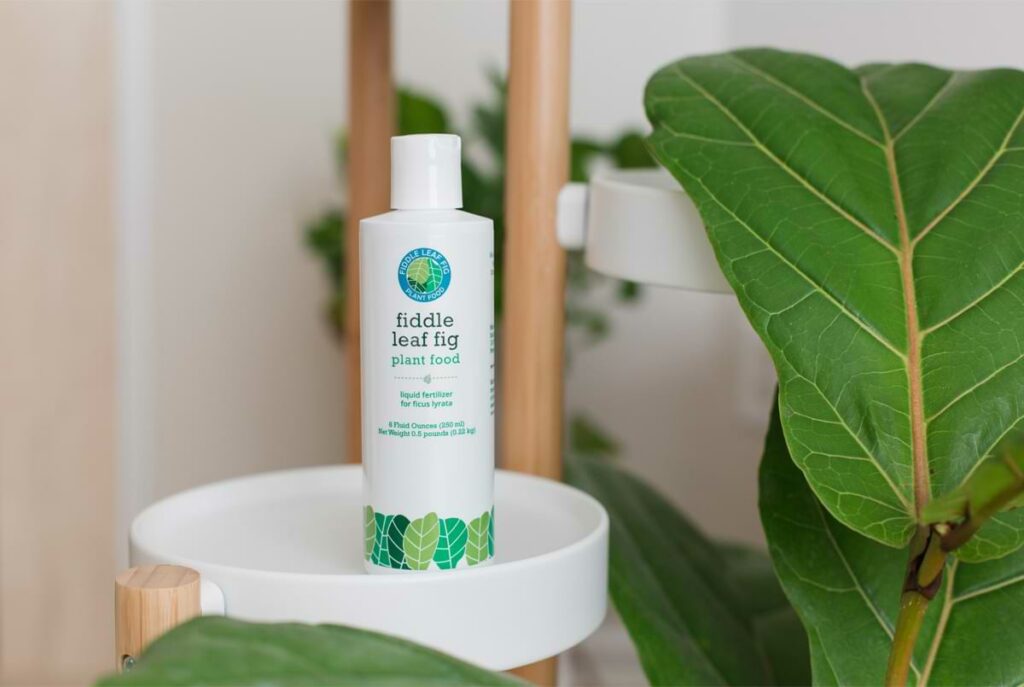
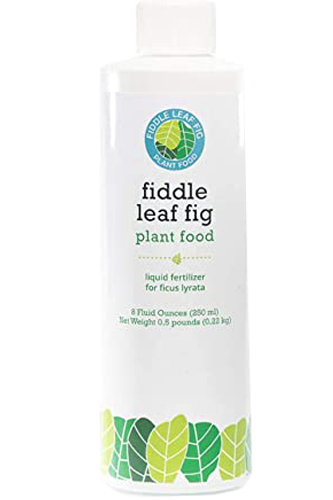
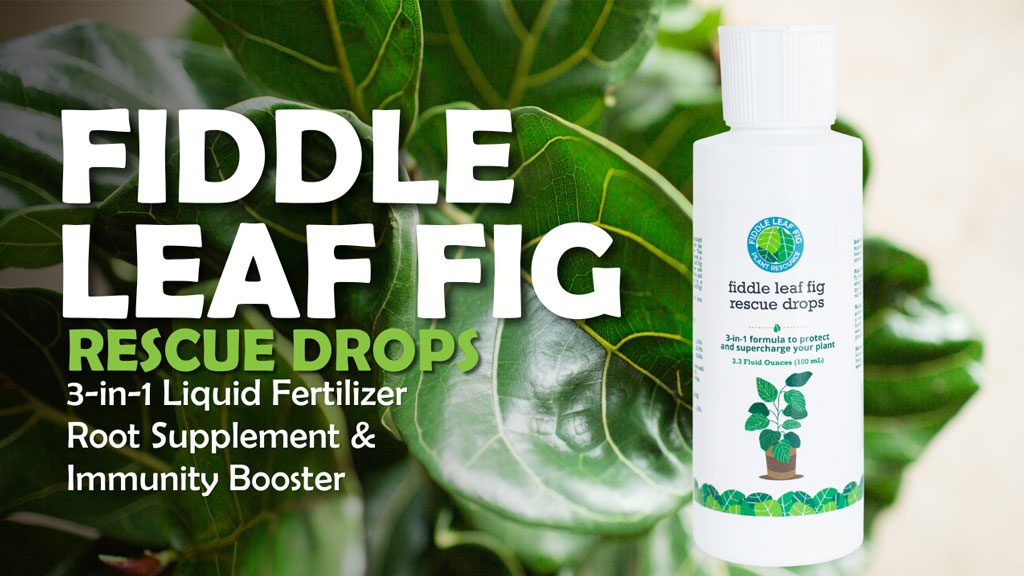

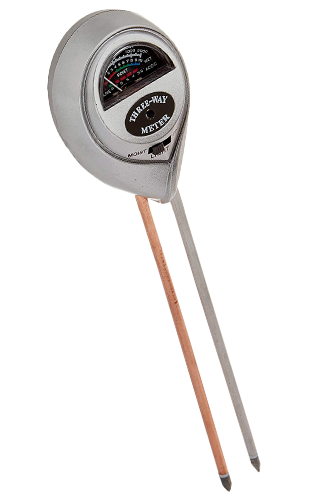









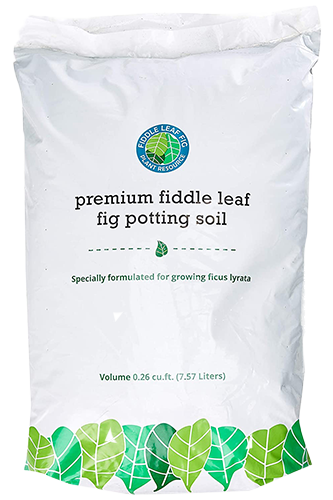


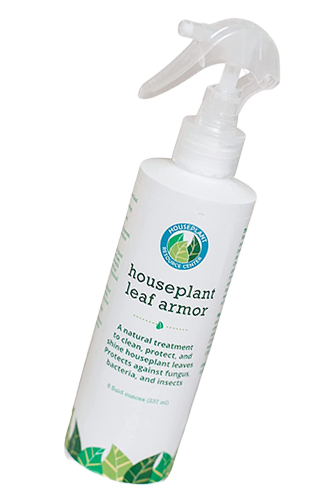
The bottle says 1 tsp per 2 cup water and I’ve been fertilizing mine once a month since late February. I noticed a lot of new growth and big leaves, but they seemed to be growing slower than the first month I fertilized them. I’m not sure if they’re actually growing slower or I’m looking at them more frequently–making it look like they’re growing slower. Anyways, should I be fertilizing more frequently–I water every week with about 4-5 cups of water–and with 1 tsp fertilizer per cup of water? What are the signs of over fertilizing the plant? Just to make sure I can notice and cut back if needed. Thanks!
I would only fertilize every week – part of the restriction on growth is light. If you can give your plant more light it will do better. But there’s no way to force them to grow faster once they have all that they need. Signs of over fertilizing are burnt or dried leaf margins and yellowing in some cases. Claire